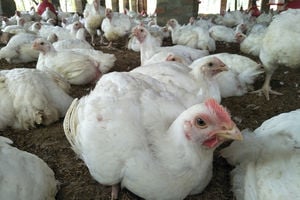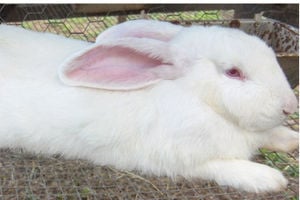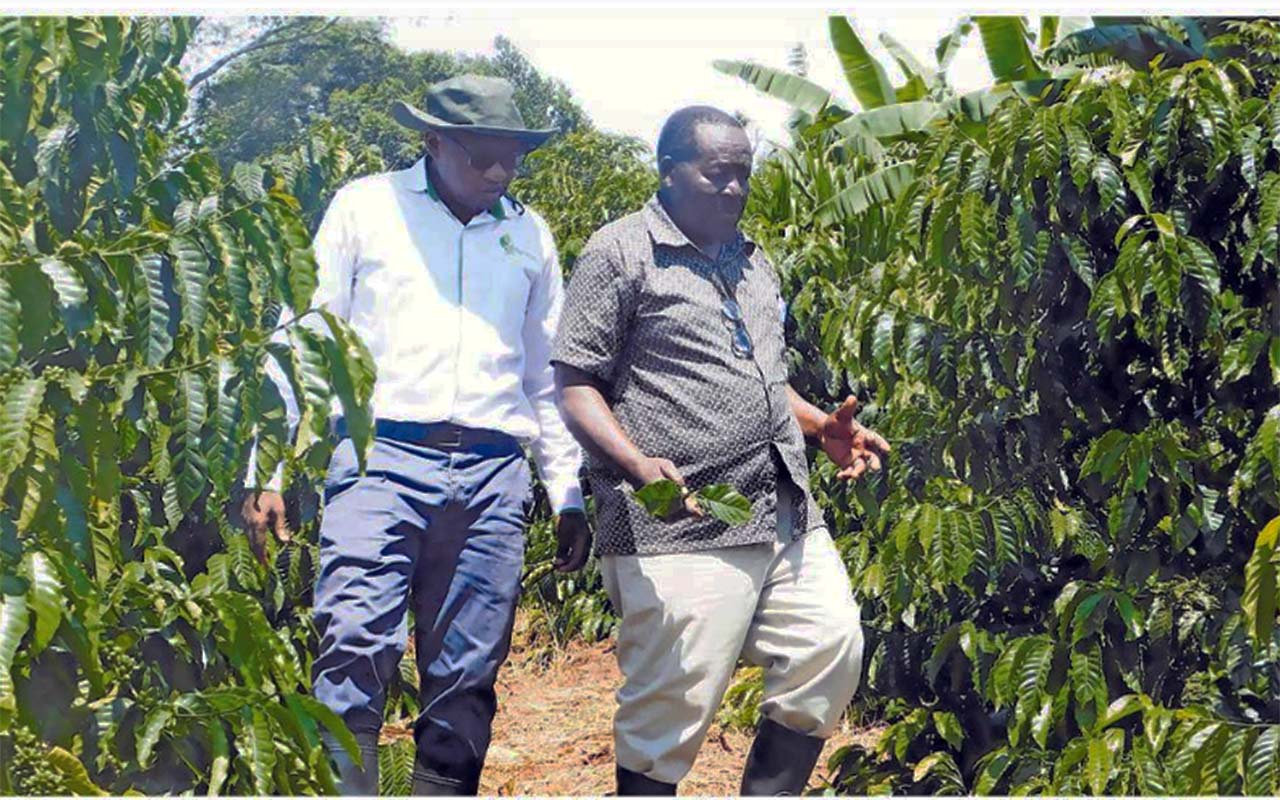
Hilda Victoria Namulwana feeds her birds three times a day. Photos | Abdul Nasser Ssemugabi
Poultry spend nearly all their time in close contact with the litter underfoot, so it is no surprise that poor litter conditions can severely impact their health and performance.
Bedding depth matters as much as bedding type. Industry standards recommend a minimum depth of 5 cm, but it is not unusual to find inconsistencies across the shed, according to Dr Dickson Tayebwa, a lecturer in the Faculty of Veterinary Medicine at Makerere University.
Proper litter management
Proper litter management is essential for maintaining bird health and ensuring they reach their genetic potential. When neglected, litter quickly transforms from a bed of support into a breeding ground for health risks that compromise flock performance, welfare, and, ultimately, profits.
Litter in poultry farming is not merely bedding material; it is a crucial part of a bird’s living environment. Typically composed of wood shavings, straw, or other organic materials, litter absorbs moisture, captures feces, and reduces odors, keeping chickens dry and comfortable.
Properly maintained litter also helps birds naturally scratch and dust-bathe, which are essential for their mental well-being.
However, when litter quality deteriorates, it can no longer absorb moisture effectively, and instead begins to harbor bacteria, parasites, and harmful gases such as ammonia.

Poor litter conditions
Poor litter conditions can cause birds to develop respiratory problems, foot lesions, eye irritation, and even infections that spread rapidly through flocks.
These health issues have a direct impact on growth, egg production, and feed conversion, cutting into both the welfare and productivity of poultry operations.
Dr Tayebwa says, “Ammonia build-up is one of the biggest issues in poorly managed litter. Ammonia irritates a bird’s respiratory system and impairs its immune response, making it more susceptible to diseases. In environments with high ammonia, we often see increased respiratory infections and reduced feed intake, which slows down growth.”
Poor litter quality does not just lead to sick birds; it severely impacts productivity. In broilers, for instance, respiratory issues can limit weight gain, as birds must expend energy to breathe rather than grow.
In laying hens, chronic exposure to high ammonia levels can result in lowered egg production and poorer egg quality. Farmers also feel the financial impact through increased veterinary costs and feed expenses.
When birds are unhealthy, they do not use feed as efficiently, requiring more input to achieve the same level of output. Moreover, the cost of managing outbreaks of diseases linked to poor litter, such as coccidiosis, can quickly escalate.
Signs of poor litter conditions
Recognizing the signs of deteriorating litter conditions is essential in poultry keeping, according to Micheal Kigozi, a poultry farmer. If you can smell ammonia when you enter a poultry house, levels are likely high enough to irritate your birds’ respiratory systems.
Litter that feels wet or has formed solid cakes is less effective at absorbing moisture and tends to harbor bacteria.
Kigozi says, “If birds display more respiratory issues, footpad dermatitis, or other infections, it is worth examining litter conditions. Stress from poor litter conditions can increase feather pecking as birds seek to relieve discomfort.”
Litter-borne diseases
Litter-borne diseases in poultry are illnesses that emerge from pathogens thriving in the bedding material used in poultry houses.
Poor litter management can create ideal conditions for harmful bacteria, fungi, parasites, and viruses, leading to a variety of health issues that significantly impact poultry welfare and productivity.
Here are some common litter-borne diseases, their causes, and preventive strategies:
Coccidiosis
Coccidiosis is caused by Coccidia parasites (Eimeria species) that thrive in warm, moist litter. It manifests with symptoms such as diarrhea, weight loss, reduced growth, pale combs, and lethargy. Severe cases may cause bloody droppings. The disease causes stunted growth in broilers and lowers egg production in layers.
Aspergillosis
Aspergillosis is caused by Aspergillus fungi, especially Aspergillus fumigatus, which grows in damp litter. Its symptoms include respiratory distress, difficulty breathing, gasping, weakness, and sometimes neurological signs if the infection spreads. It can lead to high mortality, especially in young birds, and chronic respiratory issues in survivors.
Other bacterial infections
Escherichia coli and Salmonella bacteria proliferate in dirty, wet litter with high fecal matter content. They cause symptoms such as diarrhea, respiratory issues, septicemia, and poor growth. Some strains can cause joint inflammation (arthritis) and other localized infections. These infections lower productivity, increase mortality, and pose a risk of zoonotic transmission to humans through contaminated products.
Footpad dermatitis
Prolonged exposure to wet, caked, or acidic litter causes footpad dermatitis, leading to inflammation and lesions on footpads. Visible foot sores, limping, reluctance to move, and sometimes infections if the wounds get contaminated are some of the signs of footpad dermatitis. It reduces welfare and productivity, as affected birds struggle to move and feed efficiently. Severe cases may lead to systemic infections.
Proactive and sustainable solutions
Improving litter quality requires consistent maintenance, proactive management, and a few essential practices. Preventing litter-borne diseases requires proactive litter management and biosecurity practices, according to Dr Tayebwa.
He advises that a farmer should regularly clean and disinfect poultry houses, equipment, and feeding areas to control pathogen load.
“Regularly check for moisture and replace wet or caked litter to disrupt pathogen development cycles. Ensure that poultry housing is well-ventilated to keep ammonia levels low and moisture under control,” he says.
As a farmer, it is important to watch for early signs of illness and remove sick birds immediately to prevent the spread of disease. Overcrowded conditions also contribute to higher litter moisture, heat, and fecal load, which foster disease spread.
“Effective litter management is not only crucial for maintaining healthy flocks but also for improving productivity and ensuring sustainable poultry operations. Proper litter hygiene, combined with attention to environmental controls and biosecurity measures, can make a significant difference in reducing disease and improving overall flock performance,” Kigozi says.







